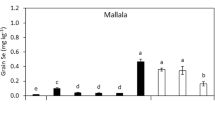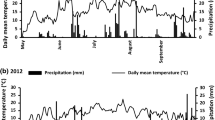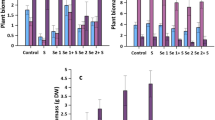Abstract
Selenium (Se) is an essential trace element for humans and livestock. In the UK, human Se intake and status has declined since the 1980s. This is primarily due to the increased use of wheat (Triticum aestivum L.) grown in UK soils which are naturally low in Se. The aim of this study was to determine the potential for increasing grain Se concentration in a high-yielding UK wheat crop using fertilisers. The crop response of winter-wheat to Se fertilisation was determined under standard field conditions in two consecutive years at up to 10 sites. Selenium fertilisers were applied as high-volume drenches of sodium selenate solution, or as granular Se-containing products. Yield and harvest index were unaffected by Se fertilisation. Under all treatments, grain Se concentration increased by 16–26 ng Se g−1 fresh weight (FW) per gram Se ha−1 applied. An application of 10 g Se ha−1 would thereby increase the Se concentration of most UK wheat grain 10-fold from current ambient levels and agronomic biofortification of UK-grown wheat is feasible. Total recovery (grain and straw) of applied Se was 20–35%. The fate of Se in the food-chain and in the soil must be determined in order to optimize the efficiency of this process.




Similar content being viewed by others
References
Adams ML, Lombi E, Zhao F-J, McGrath SP (2002) Evidence of low selenium concentrations in UK bread-making wheat grain. J Sci Food Agric 82:1160–1165
Avery BW (1973) Soil classification in the Soil Survey of England and Wales. Eur J Soil Sci 24:324–338
Boila RJ, Stothers SC, Campbell LD (1993) The concentration of selenium in the grain from wheat, barley and oats grown at selected locations throughout Manitoba. Can J Anim Sci 73:217–221
British Crop Protection Council (2001) Hand-held and amenity sprayers handbook. BCPC, Alton
Broadley MR, White PJ, Bryson RJ, Meacham MC, Bowen HC, Johnson SE, Hawkesford MJ, McGrath SP, Zhao F-J, Breward N, Harriman M, Tucker M (2006) Biofortification of U.K. food crops with selenium (Se). Proc Nutr Soc 65:169–181
Chamberlain N, Collins TH, Elton GAH, Hollingsworth DF, Lisle DB, Payne PR (1966) Studies on the composition of food. 2. Comparison of the nutrient content of bread made conventionally and by the Chorleywood Bread Process. Br J Nutr 20:747–755
Combs GF (2001) Selenium in global food systems. Br J Nutr 85:517–547
Curtin D, Hanson R, van der Weerden TJ (2008) Effect of selenium fertiliser formulation and rate of application on selenium concentrations in irrigated and dryland wheat (Triticum aestivum). N Z J Crop Hortic Sci 36:1–7
Department of Health (1991) Dietary reference values for food, energy and nutrients for the UK. Her Majesty’s Stationery Office (HMSO), London
Ducsay L, Ložek O (2006) Effect of selenium foliar application on its content in winter wheat grain. Plant Soil Environ 52:78–82
Ekholm P, Reinivuo H, Mattila P, Pakkala H, Koponen J, Happonen A, Hellstrom J, Ovaskainen ML (2007) Changes in the mineral and trace element contents of cereals, fruits and vegetables in Finland. J Food Compos Anal 20:487–495
Eurola MH, Ekholm PI, Ylinen ME, Koivistoinen PE, Varo PT (1991) Selenium in Finnish foods after beginning the use of selenate supplemented fertilizers. J Sci Food Agric 56:57–70
Eurola M, Hietaniemi V, Kontturi M, Tuuri H, Kangas A, Niskanen M, Saastamoinen M (2004) Selenium content of Finnish oats in 1997–1999: effect of cultivars and cultivation techniques. Agr Food Sci 13:46–53
Fan M-S, Zhao F-J, Poulton PR, McGrath SP (2008) Historical changes in the concentrations of selenium in soil and wheat grain from the Broadbalk experiment over the last 160 years. Sci Total Environ 389:532–538
Food Standards Agency (2009) Measurement of the concentrations of metals and other elements from the 2006 UK total diet study. Food Surveillance Information Sheet 01/09. January 2009 [online]. Available at: http://www.food.gov.uk/multimedia/pdfs/fsis0109metals.pdf [Accessed 10 August 2009]
Fordyce F (2005) Selenium deficiency and toxicity in the environment. In: Selinus O, Alloway B, Centeno J, Finkelman R, Fuge R, Lindh U, Smedley P (eds) Essentials of medical geology. Elsevier, London, pp 373–415
US Geological Survey (2009) U.S. Geological Survey, Mineral Commodity Summaries. Selenium. January 2009 [online]. Available at: http://minerals.usgs.gov/minerals/pubs/commodity/selenium/mcs-2009-selen.pdf [Accessed 9 June 2009]
Gissel-Nielsen G (1998) Effects of selenium supplementation of field crops. In: Frankenberger WT, Engberg RA (eds) Environmental chemistry of selenium. Dekker, New York, pp 99–112
Graham RD, Welch RM, Saunders DA, Ortiz-Monasterio I, Bouis HE, Bonierbale M, de Haan S, Burgos G, Thiele G, Liria R, Meisner CA, Beebe SE, Potts MJ, Kadian M, Hobbs PR, Gupta RK, Twomlow S (2007) Nutritious subsistence food systems. Adv Agron 92:1–74
Grant CA, Buckley WT, Wu R (2007) Effect of selenium fertilizer source and rate on grain yield and selenium and cadmium concentration of durum wheat. Can J Plant Sci 87:703–708
Gupta UC, Gupta SC (2002) Quality of animal and human life as affected by selenium management of soils and crops. Commun Soil Sci Plant Anal 33:2537–2555
Hahn MH, Kuennen RW, Caruso JA, Fricke FL (1981) Determination of trace amounts of selenium in corn, lettuce, potatoes, soybeans, and wheat by hydride generation/condensation and flame atomic absorption spectrometry. J Agric Food Chem 29:792–796
Hartikainen H (2005) Biogeochemistry of selenium and its impact on food chain quality and human health. J Trace Elem Med Biol 18:309–318
Hartikainen H, Xue TL (1999) The promotive effect of selenium on plant growth as triggered by ultraviolet irradiation. J Environ Qual 28:1372–1375
Haug A, Graham RD, Christophersen OA, Lyons GH (2007) How to use the world’s scarce selenium resources efficiently to increase the selenium concentration in food. Microb Ecol Health Dis 19:209–228
Hawkesford MJ, Zhao F-J (2007) Strategies for increasing the selenium content of wheat. J Cereal Sci 46:282–292
Haygarth PM, Cooke AI, Jones KC, Harrison AF, Johnston AE (1993) Long-term change in the biogeochemical cycling of atmospheric selenium: deposition to plants and soil. J Geophys Res 98:16769–16776
Lyons G, Stangoulis J, Graham R (2003) High-selenium wheat: biofortification for better health. Nutr Res Rev 16:45–60
Lyons GH, Judson GJ, Ortiz-Monasterio GY, Stangoulis JCR, Graham RD (2005) Selenium in Australia: Selenium status and biofortification of wheat for better health. J Trace Elem Med Biol 19:75–82
Lyons GH, Genc Y, Soole K, Stangoulis JCR, Liu F, Graham RD (2009) Selenium increases seed production in Brassica. Plant Soil 318:73–80
NDNS (2004) The National Diet and Nutrition Survey: adults aged 19 to 64 years. Volume 5: Summary Report. Her Majesty’s Stationery Office (HMSO), Norwich
Rayman MP (2004) The use of high-selenium yeast to raise selenium status: how does it measure up? Br J Nutr 92:557–573
Rayman MP (2008) Food-chain selenium and human health: emphasis on intake. Br J Nutr 100:254–268
Ríos JJ, Blasco B, Cervilla LM, Rosales MA, Sanchez-Rodriguez E, Romero L, Ruiz JM (2009) Production and detoxification of H2O2 in lettuce plants exposed to selenium. Ann Appl Biol 154:107–116
Stroud JL, Broadley MR, Foot I, Fairweather-Tait SJ, Hart DJ, Hurst R, Knott P, Mowat H, Norman K, Scott P, Tucker M, White PJ, McGrath SP, Zhao FJ (2010a) Soil factors affecting selenium concentration in wheat grain and the fate and speciation of Se fertilisers applied to soil. Plant Soil, in press. doi:10.1007/s11104-009-0230-8
Stroud JL, Li HF, Lopez-Bellido FJ, Broadley MR, Foot I, Fairweather-Tait SJ, Hart DJ, Hurst R, Knott P, Mowat H, Norman K, Scott P, Tucker M, White PJ, McGrath SP, Zhao FJ (2010b) Impact of sulphur fertilisation on crop response to selenium fertilisation. Plant Soil, in press. doi:10.1007/s11104-009-0229-1
Thomson CD (2004) Selenium and iodine intakes and status in New Zealand and Australia. Br J Nutr 91:661–672
Thomson CD, Robinson MF (1996) The changing selenium status of New Zealand residents. Eur J Clin Nutr 50:107–114
Turakainen M, Hartikainen H, Seppänen MM (2004) Effects of selenium treatments on potato (Solanum tuberosum L.) growth and concentrations of soluble sugars and starch. J Agric Food Chem 52:5378–5382
Van Hoewyk D, Takahashi H, Inoue E, HessA TM, Pilon-Smits EAH (2008) Transcriptome analyses give insights into selenium-stress responses and selenium tolerance mechanisms in Arabidopsis. Physiol Plant 132:236–253
Watkinson JH (1981) Changes of blood selenium in New Zealand adults with time and importation of Australian wheat. Am J Clin Nutr 34:936–942
White PJ, Broadley MR (2005) Biofortifying crops with essential mineral elements. Trends Plant Sci 10:586–593
White PJ, Broadley MR (2009) Biofortification of crops with seven mineral elements often lacking in human diets—iron, zinc, copper, calcium, magnesium, selenium and iodine. New Phytol 182:49–84
White PJ, Bowen HC, Parmaguru P, Fritz M, Spracklen WP, Spiby RE, Meacham MC, Harriman M, Trueman LJ, Smith BM, Thomas B, Broadley MR (2004) Interactions between selenium and sulphur nutrition in Arabidopsis thaliana. J Exp Bot 55:1927–1937
Wolnik KA, Fricke FL, Capar GL, Braude MW, Meyer MW, Satzger RD, Kuennen RW (1983) Elements in major raw agricultural crops in the United States. 2. Other elements in lettuce, peanuts, potatoes, soybeans, sweet corn, and wheat. J Agric Food Chem 31:1244–1249
Xue TL, Hartikainen H (2000) Association of antioxidative enzymes with the synergistic effect of selenium and UV irradiation in enhancing plant growth. Agric Food Sci Finl 9:177–186
Zadoks JC, Chang TT, Konzak CF (1974) A decimal code for the growth stages of cereals. Weed Res 14:415–421
Acknowledgements
The work was conducted under the Department for the Environment, Food and Rural Affairs (Defra) Sustainable Arable LINK Programme (LK0974; 2005–2009). The study was funded 50% by Defra and 50% by industry. Project participants from all industry partners are named as co-authors. The academic partners (from UoN, RRes, SCRI, IFR, UEA) have no personal financial interests in any of the companies involved in funding this study. Rothamsted Research is an institute of the UK Biotechnology and Biological Sciences Research Council.
Author information
Authors and Affiliations
Corresponding author
Additional information
Responsible Editor: Peter Christie.
Rights and permissions
About this article
Cite this article
Broadley, M.R., Alcock, J., Alford, J. et al. Selenium biofortification of high-yielding winter wheat (Triticum aestivum L.) by liquid or granular Se fertilisation. Plant Soil 332, 5–18 (2010). https://doi.org/10.1007/s11104-009-0234-4
Received:
Accepted:
Published:
Issue Date:
DOI: https://doi.org/10.1007/s11104-009-0234-4




